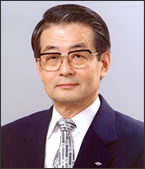
As Japan's first provider of inter-urban high-speed railway services, Hanshin Electric Railway started business operations in 1905. Before WWII, it grew rapidly, but after WWII, the speed of growth decreased due to the maturation of the markets along the railway, and to severe competition with Japan National Railways (current JR) and Hankyu Railway. Since then, stability and conservatives became the characteristics of the company. In the 1980s, the weakening of Hanshin's railway business bases came to light due to an economic downturn in the Osaka area and the pending privatization of Japan National Railways. It was in the early 1980s that Hanshin radically redirected its business strategy toward expansion to strengthen railway and other related businesses, and pursued this by developing the Nishi-Umeda area and extending its Nishi-Osaka Line. Kyoji Nishikawa acted as technical leader in these two major projects.
Born in 1939 in Hikone, Shiga Prefecture, Nishikawa joined Japan National Railways in 1965 after acquiring a Master's degree in civil engineering from the Graduate School of Engineering (Civil Engineering), Kyoto University. After being involved in core technical projects for JNR, such as the Osaka Station redevelopment project and the extension of the Tohoku Shinkansen to Ueno Station, Nishikawa joined Hanshin Railway Co., Ltd. in 1986. As the manager of the Nishi-Umeda development project and the manager of the Railway Business Division, Nishikawa took a leadership role in laying the foundations of the Nishi-Umeda development project, the restoration project after the Hanshin-Awaji Earthquake, and the Nishi-Osaka Line extension project. In June 2004, Nishikawa was appointed the company's 18th President. Following the expansion-oriented strategy of Shunjiro Kuma, the 16th president and father of the company's rehabilitation, and Masatoshi Tezuka, the 17th president, Nishikawa set as his strategic objectives the transformation from a stock-type business to a flow-type business and the enhancement of the Hanshin group's brand values.
Although the company experienced a serious setback due to the Hanshin-Awaji Earthquake in 1995, the Hanshin Railway Group showed steady performance among major private railway companies from the 1980s to the early 21st Century. In FY2003, sales and profits hit a record high. Thanks to the change in strategy, the company's assets included an increased volume of unrealized profits. In the fall of 2005, the so-called "Murakami Fund", noticing the existence of these latent corporate values, acquired a large number of its shares, to the extent that the company was in danger of losing control of its management. After many twists and turns that lasted for approximately 6 months, Hanshin Electric Railway announced in May 2006 that it had agreed to merge the company management with Hankyu Holdings and to become a subsidiary of Hankyu Hanshin Holdings, Inc. by share exchanges, effective on October 1, 2006. With this, Nishikawa stepped down as President and became Special Advisor in June 2006.
|